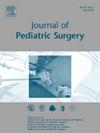Complications After Surgery for Anorectal Malformations: An ARM-Net consortium Registry Study
IF 2.5
2区 医学
Q1 PEDIATRICS
引用次数: 0
Abstract
Objective
Establishing the incidence and types of complications following surgical intervention for ARM, primarily after reconstruction. Patient- and treatment-related risk factors were also determined.
Background
Postoperative complications of ARM surgery vary widely, with data predominantly derived from single-center retrospective studies with limited number of patients. Whether factors such as ARM type, associated congenital anomalies, prior enterostomy, or type of reconstructive surgery affect complication incidence remains unclear.
Methods
This multicenter cohort study was performed using the ARM-Net registry with prospectively collected data. Enterostomy-related and post-reconstructive complications in patients who underwent reconstructive surgery before the age of five years were recorded. Patients with more than 25 % missing data, unknown sex, ARM type, or reconstruction date, or without (information on) reconstruction or complications, were excluded. Multivariable analyses identified independent risk factors for the development of complications.
Results
A total of 2,043 patients were eligible for analysis. Complications after enterostomy formation and closure occurred in 25 % and 12 % of patients, respectively. Post-reconstructive complications occurred in 25 % of patients, with wound complications comprising half of the complications. In a multivariable analysis, recto-bladder neck fistula, any associated anomaly, and the LAARP procedure were identified as independent risk factors for post-reconstructive complications. In contrast, anoplasty and mini-PSARP reduce the risk of complications.
Conclusions
Post-reconstructive complications in ARM patients are common, and certain patient- and treatment-related characteristics affect postoperative outcomes. These results aid counselling and clinical decision-making, and may guide the operative planning of ARM types that are amenable to several different surgical approaches.
肛肠畸形手术后的并发症:ARM-Net联盟注册研究。
目的:了解ARM手术干预后并发症的发生率和类型,主要是术后重建。患者和治疗相关的危险因素也被确定。背景:ARM手术的术后并发症差异很大,数据主要来自数量有限的单中心回顾性研究。诸如ARM类型、相关先天性异常、既往肠造口或重建手术类型等因素是否影响并发症发生率尚不清楚。方法:本多中心队列研究采用ARM-Net注册表进行前瞻性数据收集。记录5岁前接受肠造口手术患者的肠造口相关并发症和肠造口术后并发症。数据缺失、性别、ARM类型或重建日期未知、无(信息)重建或并发症超过25%的患者被排除在外。多变量分析确定了并发症发生的独立危险因素。结果:共有2043例患者符合分析条件。肠造口形成和闭合后的并发症发生率分别为25%和12%。25%的患者出现重建后并发症,其中伤口并发症占并发症的一半。在多变量分析中,直肠-膀胱颈瘘、任何相关异常和LAARP手术被确定为重建后并发症的独立危险因素。相比之下,肛门成形术和mini-PSARP可降低并发症的风险。结论:ARM患者重建后并发症很常见,某些与患者和治疗相关的特征影响术后预后。这些结果有助于咨询和临床决策,并可能指导适合几种不同手术入路的ARM类型的手术计划。
本文章由计算机程序翻译,如有差异,请以英文原文为准。
求助全文
约1分钟内获得全文
求助全文
来源期刊
CiteScore
1.10
自引率
12.50%
发文量
569
审稿时长
38 days
期刊介绍:
The journal presents original contributions as well as a complete international abstracts section and other special departments to provide the most current source of information and references in pediatric surgery. The journal is based on the need to improve the surgical care of infants and children, not only through advances in physiology, pathology and surgical techniques, but also by attention to the unique emotional and physical needs of the young patient.

 求助内容:
求助内容: 应助结果提醒方式:
应助结果提醒方式:


